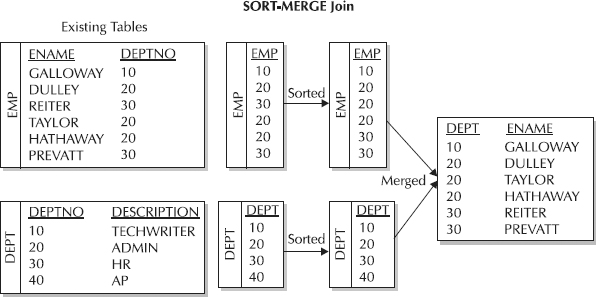Suppose two salespeople attend a conference and each collect over 100 business cards from potential new customers. They now each have a pile of cards in random order, and they want to see how many cards are duplicated in both piles. The salespeople alphabetize their piles, and then they call off names one at a time. Because both piles of cards have been sorted, it becomes much easier to find the names that appear in both piles. This example describes a SORT-MERGE join.
In a SORT-MERGE join, Oracle sorts the first row source by its join columns, sorts the second row source by its join columns, and then merges the sorted row sources together. As matches are found, they are put into the result set. SORT-MERGE joins can be effective when lack of data selectivity or useful indexes render a NESTED LOOPS join inefficient, or when both of the row sources are quite large (greater than 5 percent of the blocks accessed).
However, SORT-MERGE joins can be used only for equijoins (WHERE D.deptno = E.deptno, as opposed to WHERE D.deptno >= E.deptno). SORT-MERGE joins require temporary segments for sorting (if SORT_AREA_SIZE or the automatic memory parameters like MEMORY_TARGET are set too small). This can lead to extra memory utilization and/or extra disk I/O in the temporary tablespace. Table 1 below illustrates the method of executing the query shown next when a SORT-MERGE join is performed.
![]()

Table 1. SORT-MERGE join
Leave a Reply